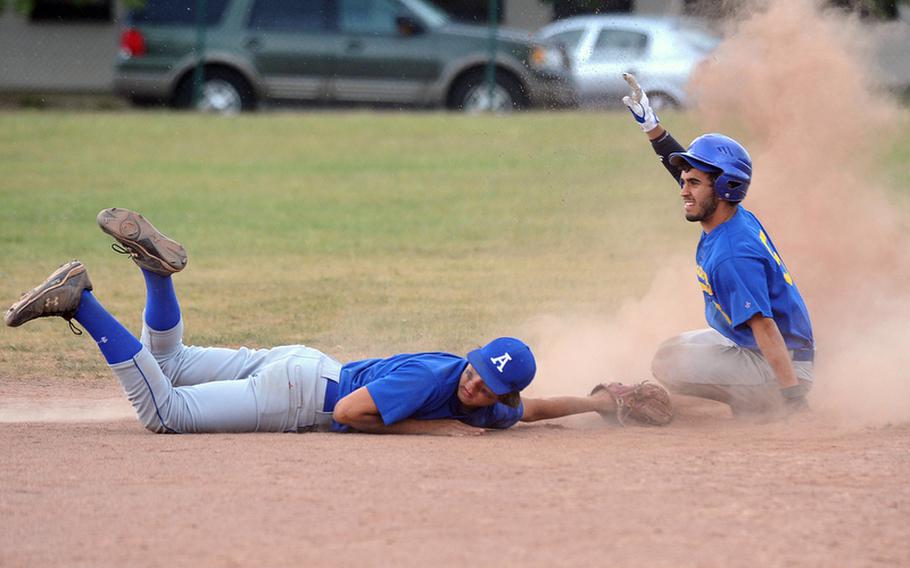
Rota's Cody Holland, left, and Sigonella's Marco Summerfield wait for the umpire's call at second. Summerfield was safe, but Rota won the Division III game 8-6 on opening day of 2011's DODDS-Europe baseball championship. The Admirals went on to take the Division III title with a 7-6 win over the Jaguars. (Michael Abrams/Stars and Stripes)
It might be the national pastime, but for Europe’s smallest high schools, baseball’s an annual challenge.
So much so, in fact, that just two of them are on board for this month’s European tournament at Kaiserslautern and Ramstein. Assembling enough players, finding enough games, scrounging up the facilities, coping with the remoteness of many small schools from their counterparts and battling Europe’s generally rainy spring weather make manning the diamond a bit too rough for most of the continent’s Division III schools.
Leading off against the small schools is the numbers problem. Each spring, DODDS-Europe offers baseball and softball, boys’ and girls’ soccer and track and field to its student athletes.
The praiseworthy number of choices, however, puts real pressure on the limited populations at many D-II schools, let alone D-III schools. It’s no surprise, therefore, that the two schools still planning to play in this year’s baseball tournament – Alconbury and defending D-III champion Rota – are among the biggest of the small. Rota’s No. 2 among D-III schools with a grades 9-12 population of 143, and Alconbury’s No. 3 at 142.
The numbers problem came into focus earlier this week when Sigonella, enrollment 87, was forced to drop out of the European tournament because of too few players.
Bamberg’s the biggest D-III school with 151 students, and Brussels is fourth with 104, and it’s indicative of the numbers problem that neither of them is playing baseball. If they were, moreover, it’d be at the expense of another sport. Bamberg’s girls, for example, elected to play softball this spring and as a result, there weren’t enough girls left to form a soccer team. The same undoubtedly would have applied to baseball.
The situation’s the same at Brussels.
“Once in 2002 and then in 2006, I conducted a survey of 8-11th graders to see if there was enough interest to shift from soccer to baseball/softball,” Brussels athletic director Mark McVicker emailed on Monday. “We (myself, coaching staff and administration) felt we could not possibly field both a baseball/softball team and a soccer team with our small population, so it was presented as ‘either-or.’ ”
Either-or was the case at Menwith Hill, enrollment 72, too, according to Mustangs’ AD Pete Resnick, who mentioned as an aside he knew of no baseball field in “all of northern England.”
Even so, “We gave both the girls and boys a choice of either softball-soccer or baseball-soccer,” Resnick wrote in a Monday email. “They chose to play soccer.”
Even at Alconbury, with nearly twice the enrollment of Menwith Hill, fielding a complete slate of spring sports diluted the school’s talent pool, according to AD Bruce Ballard, who as late as Monday called it a 50-50 proposition that his team would be able to suit up enough players to participate in Europeans.
“The addition of baseball has drawn away some who would have come out for track,” Ballard emailed on Monday.
Geographical remoteness affects D-III, too. Lajes is so far out in the Atlantic and so small, 55 students, that the Falcons’ co-ed soccer team consumes 37 percent of the student body, emailed Lajes AD Carter Hoff. Sigonella gets a schedule of regular-season baseball games, although they’re all against D-II schools, but for Rota it’s a different story.
“When the schedule came out, I went to my AD and asked, ‘Where are the rest of the games?’” first-year Rota coach Chris Kaldahl said by telephone on Monday night. “He said: ‘You’ve got to find them.’”
Kaldahl did, pitting his then-17-man squad, which has since lost players to the normal attrition of eligibility and military moves, against the base team and scheduling games, only to see them rained out, against a Spanish club team. Rain also cost Rota half its regular-season DODDS schedule April 28 at Alconbury.
“I don’t know what the answer is,” said Kaldahl, a new hire from Arlington, Va., who teaches physics and chemistry. “We shouldn’t fly everywhere to have games because the students would miss too much school. The educational component has to come first.”
Kaldahl concluded that D-III baseball is what it is. And what it is, for all its challenges, is educational.
“When you look at taking time to go to a tournament where there are just two other teams,” he said, “your head says, ‘This is ridiculous.’ But your heart tells you what a learning experience this is for your players.”